As long as you nail your SEO, your writing quality can come in second place. Right?
…Nope! Stop right now!
Many times, good SEO writing is forgotten by the traditional SEO writer.
That includes forgetting about engaging and thus converting a reader to your side – whether that means list sign-ups, opt-ins, or some other action.
That’s a sad mistake.
Sometimes, engaging copy is better than SEO.
Google’s standards demand useful, quality, engaging copy over any other factor – including optimizing your content, optimizing your images, and even making sure your site is mobile-friendly.
Writing for users is more important than writing for machines and algorithms.

In particular, Google relies on two acronyms to sift the high-quality content from the clunky, useless, low-quality stuff:
How Does Google Judge Good Content? They’ve Put it in Acronyms: E.A.T. and Y.M.Y.L.
We first learned these acronyms when Google released their Search Quality Evaluator Guidelines in 2015.
Google’s human ranking evaluators use them to help determine a page’s level of quality.
- E.A.T. stands for “Expertise, Authoritativeness, Trustworthiness” – High-quality content contains all three of these factors, no matter the topic or industry.
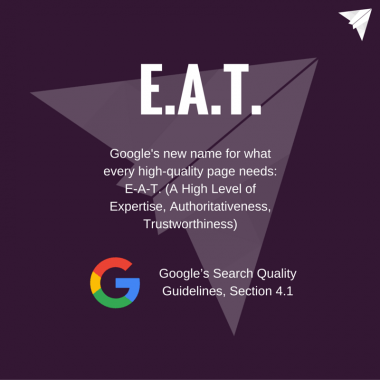
- Y.M.Y.L stands for “Your Money or Your Life” – This is content that could affect the reader’s happiness, health, finances, or well-being. If it’s low-quality, it could hurt the reader in more ways than one.
These acronyms are a good indicator of what’s important to Google.
It’s certainly not SEO in that top spot; it’s the user experience.
This is why you need better copy, and thus better content, that engages and converts your readers.
(Learn more about E.A.T., Y.M.Y.L., and Google’s guidelines.)
10 Conversion Copy Tips for Better, More Human-Friendly SEO Content
How can you get better, user-oriented copy?
Try implementing any of these conversion copy techniques.
1. Structure Your Copy Like Building a House
Thinking of the major points in your copy as separate entities is a mistake.
Instead, you should try to link your ideas together in a coherent way.
Think of it like building a house.
First, you lay the foundation for your main point in the intro. As you move through each section to the conclusion, the points should build on each other and work together, like how supports, framing, and beams hold up a house’s walls and roof.
To link your ideas and points together more coherently, do these things:
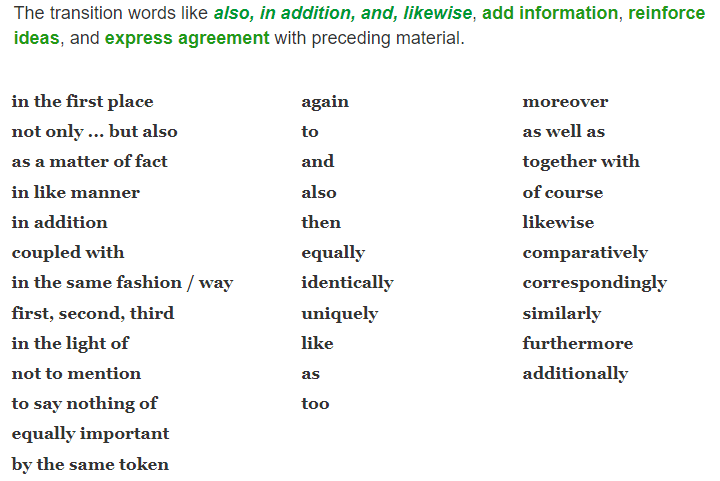
- Explain how various points are related, or how they tie together or make sense when put in context.
- Move from the least-complicated points to the most-complicated to help your reader build knowledge about the topic.
2. Understand Your Target Reader’s Level of Awareness
After making your copy easy to follow, you can boost user-friendliness by writing to the exact user who will need your content.
Each visitor to your page has a varying level of awareness about their problem and your solution. Eugene Schwartz defined five levels of consumer awareness:
- Unaware: The consumer has no idea there is a problem at all.
- Problem aware: They know what the problem is, but not how to solve it.
- Solution aware: They know what the problem is, and they know which solution they want, but they don’t know if you can deliver.
- Product aware: The consumer knows what you sell, but is on the fence about whether it’s the right choice.
- Most aware: The consumer knows your product and is ready to buy for the right price.
For effective copy, map your content to the type of reader awareness you want to target.
Then, write the copy for them.
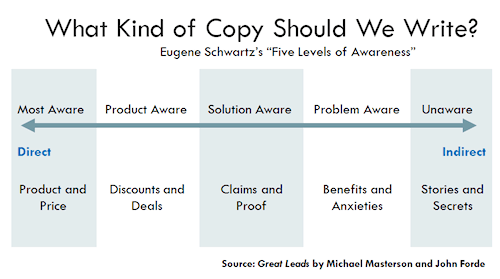
3. Spend More Time Crafting Your Intro
Crafting your introduction is equally as important as any other factor for creating compelling, useful content that converts.
Spend more time on it to perfect your hook, and implement these techniques:
- Put your opening sentence on one line (doing this forces you to take a good look at it and evaluate whether it’s attention-getting and captivating enough).
- Self-edit ruthlessly (ax filler words like “very” and “really,” and make sure sentences are clear, direct, and concise).
- State the “why” of your content piece without wasting time – why should the reader care?
4. Break Up Your Content!
One of the easiest ways to make your content more user-friendly is to break it up.
Focus on shorter paragraphs and more line breaks between them.
There should be lots of white space around your content, as well as markers that differentiate the various types of information in the piece:
- Headers.
- Subheaders.
- Numbered and bulleted lists.
- Bold/italic text.
Staring at electronic screens for long periods strains the eyes.
When you break up your content, you give your readers’ eyes a break.
Remember, this isn’t AP English class. Many of the basics you learned there for structuring and writing essays don’t apply to online writing.
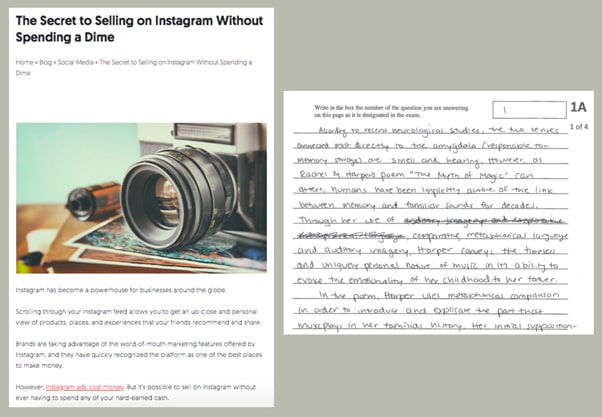 Online writing (left) vs. a school paper (right) – which would you rather read?
Online writing (left) vs. a school paper (right) – which would you rather read?5. Stay Current on Headline Best-Practices
As an SEO writer, you already know that including your target keyword in the headline is a must.
But, if that’s all you’re doing, you need to do more.
For starters, keep abreast of the latest research on types of headlines and which get the most clicks, the most shares, or the most follow-through from readers.
For instance, BuzzSumo updates their headline research regularly with new insights and stats. Their most comprehensive data is found in their analysis of 100 million article headlines, which was updated in 2017.
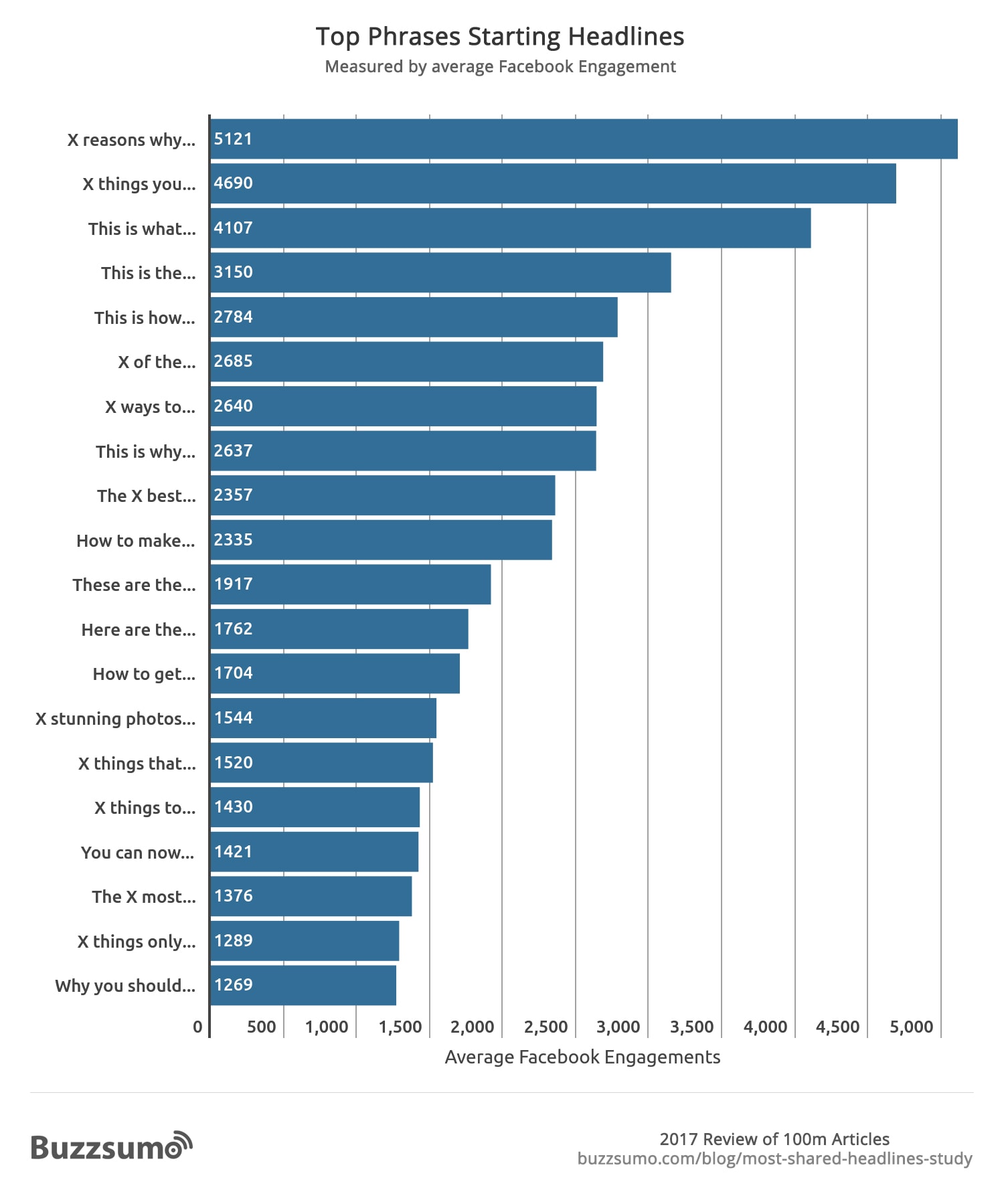
Implement the latest research in your headline writing to help make yours as tempting as possible for the modern reader.
6. Write Actionable Copy
Actionable copy is a type of writing that makes the reader feel like you’re right next to them.
It’s happening now. It’s immediate, direct, and pointed.
You’re taking the reader by the hand and leading them on a journey. You’re telling them what to do and how to do it.
How do you write actionable copy?
- Give direct commands. Tell your readers what to do using action verbs.
- Write in second-person, active voice, present tense. You’re reading an example of it at this very moment.
- On the other hand, past-tense writing happened in the past. It was over and done with long before you started reading. It sounds like this:
- SEO writers should have given blog readers more reasons to stay on the page beyond good SEO.
- The above sentence also uses third-person voice, which you should avoid. (It talks about the reader rather than to the reader.)
- On the other hand, past-tense writing happened in the past. It was over and done with long before you started reading. It sounds like this:
This SmartBlogger post on writer’s block by Hennecke Duistermaat has excellent examples of actionable copy:
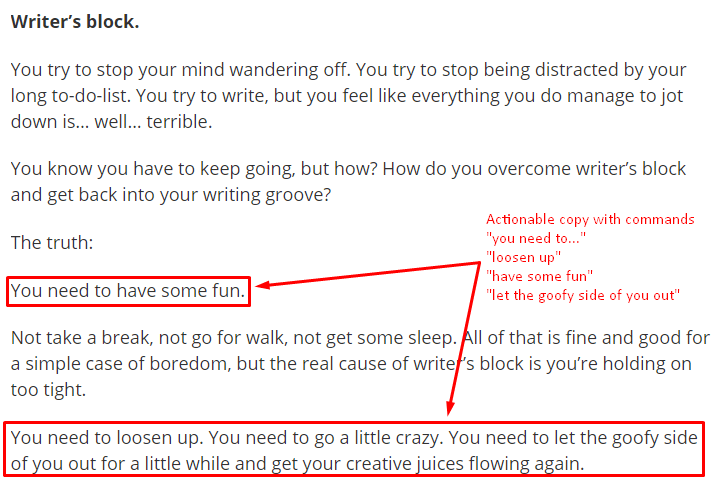
7. Use Lots of ‘You’ Language
Here’s one of the most important tips on this list:
Do not forget your audience.
If you start writing and immediately hone in on optimization/making the copy amazing for search engines, you’ll lose your readers in the process.
Where are they?
You should be imagining them sitting in front of you, a crowd of attentive faces you must keep onboard and interested.
If they have instead flown from your mind, stop.
Put the audience front-and-center by using lots of “you” language.
- Don’t say it like this: “In this post, I will explain how to correctly optimize meta descriptions.”
- Say it like THIS: “Do you want to learn how to optimize meta descriptions? Better SEO is waiting if you follow along.”
Note that I nixed the personal pronoun “I” and reworded it with “you” language.
This way, I’m no longer talking about myself; I’m talking to the reader/about their issues.
THAT is what you want.
8. Mine Your Vocabulary for Better Verbs & Adjectives
This tip is all about not settling for mediocre wording. It’s about self-editing on a sentence level to make your entire piece shine brighter.
Mediocre verbs and adjectives are non-committal, don’t provide a clear picture of what you mean, and make your writing look and sound lackluster.
Strong verbs and adjectives, on the other hand, give your writing pop, fizz, and energy, which readers love.
Words to avoid and replace in your writing:
- Thing/things: Be more specific. What “thing” are you talking about? Use that word, instead.
- Very + adjective: Any instance of very + an adjective can be replaced with a stronger word that paints a descriptive picture.
- For instance, instead of saying “very pretty,” say “beautiful,” “gorgeous,” or “stunning.”
- Adverb + weak verb: Instead of pumping up a weak verb with an adverb, find a stronger verb that does the job.
- For example, instead of saying “She ran quickly across the field,” say “She sprinted,” “She flew,” or “She rocketed across the field.”
9. Write Good CTAs
One of the integral pieces of good conversion copy is a strong call-to-action.
The CTA provides direction, encouragement, inspiration, and motivation (or all of the above) for your readers to take the action you want.
Arguably, a powerful CTA is what turns an ordinary, SEO blog post into a workhorse for any brand.
Don’t write content without providing direction on what you want the reader to do after they have finished reading. A good CTA:
- Is direct and straightforward.
- Is persuasive and powerful.
- Includes action verbs
- Talks to the reader.
- May inspire or motivate them to follow up on the action you want.
Look at this blog post from CoSchedule (“How to Pin a Tweet That Makes the Most of Your Content”) for inspiration.
The end of the post contains no less than three different instances of CTAs:
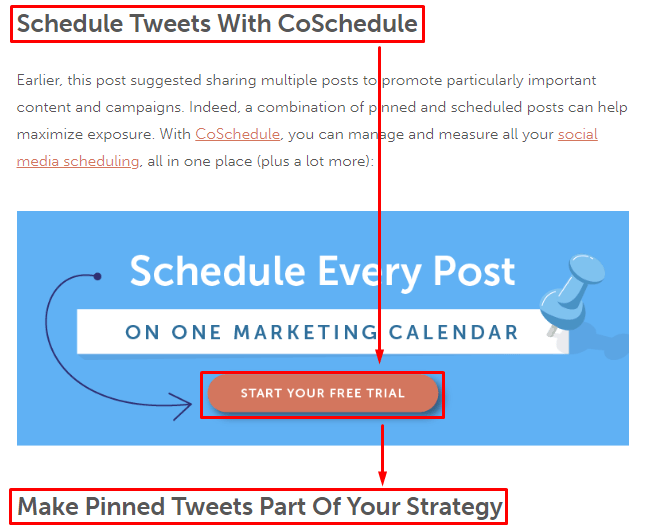
10. Use Impactful Sentences to Close Blog Posts
If the conclusions of your blog posts and articles peter out with something like a sigh and a shrug, you’ll never stay in the reader’s mind long enough to make an impact.
And, if you make no impact, your content won’t do anything, either. It won’t compel the reader to action, it won’t inspire them, and it won’t make them think deeply – all things you should want it to do.
To accomplish a stunning conclusion, try crafting it with an emphasis on the last one or two sentences. Make them count:
- Reiterate your main point, but drive it home.
- Leave the reader with a memorable image or idea related to the main point.
- End on a question for the reader that inspires them.
- Look toward the future and encourage the reader to do the same.
An example of a great, impactful ending to a blog comes from Stephanie Stahl and her post for Content Marketing Institute, “4 Secrets of Great Storytellers”:
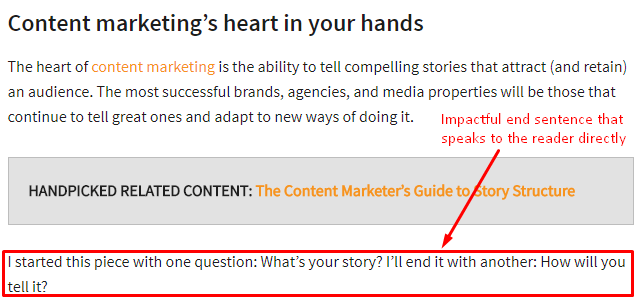
SEO Is SO Much More Than Keywords, Links & Code
Optimization is an integral chunk of making online content work. It helps your content get seen, shared, and discovered, which ultimately helps your brand.
The major takeaway, however, is this:
SEO is nothing without user-friendly, high-quality copy.
If you’re an SEO writer and have forgotten your most important critics – your human readers – it’s time to refocus. (Google is not the entity you need to impress.)
Get back to the human side of SEO, hone your copy, and the rewards are sure to follow.
More SEO & Content Marketing Resources:
Image Credits
Schwartz Awareness Scale: Recart
All screenshots taken by author, August 2018
Subscribe to SEJ
Get our daily newsletter from SEJ’s Founder Loren Baker about the latest news in the industry!
